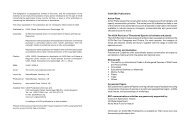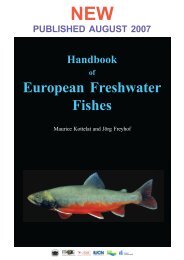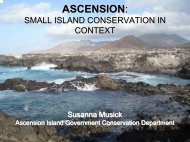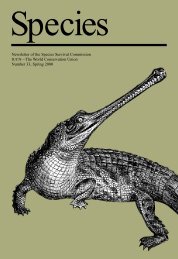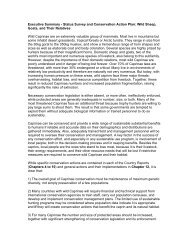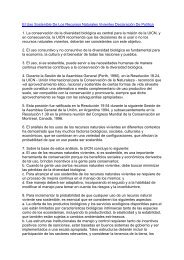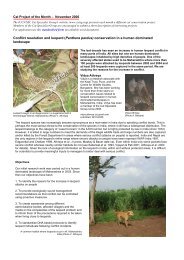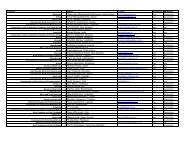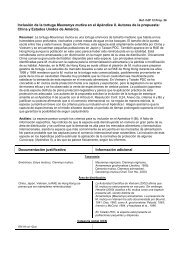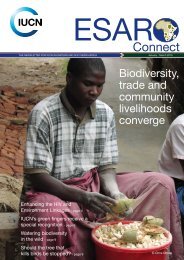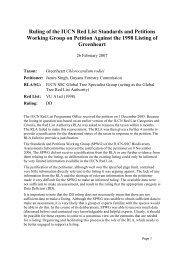Planning education to care for the earth - IUCN Knowledge Network
Planning education to care for the earth - IUCN Knowledge Network
Planning education to care for the earth - IUCN Knowledge Network
You also want an ePaper? Increase the reach of your titles
YUMPU automatically turns print PDFs into web optimized ePapers that Google loves.
Effects of <strong>education</strong> on seabird conservationcomponents: research, planning, implementation, and evaluation. Eachcomponent provided feedback <strong>to</strong> <strong>the</strong> o<strong>the</strong>rs and allowed <strong>for</strong> modificationsover <strong>the</strong> succeeding 15 years.ResearchThe problem was <strong>to</strong> understand <strong>the</strong> human and cultural context and <strong>to</strong>combine this in<strong>for</strong>mation with biological data relevant <strong>to</strong> <strong>the</strong> seabirds.Programmes could <strong>the</strong>n be developed which would lead <strong>to</strong> an appropriatemanagement policy. A face-<strong>to</strong>-face survey with heads of households in1981, conducted in people’s homes in line with <strong>the</strong> local tradition ofhospitality, had four aims: ga<strong>the</strong>r comprehensive in<strong>for</strong>mation about illegalharvesting; characterize people’s knowledge, attitudes and behavioursconcerning seabirds; locate areas where <strong>the</strong> problem was most acute; andassess public opinion about seabird management. Only 3 out of 140households sampled refused <strong>to</strong> take part.The survey revealed widespread lack of knowledge of wildlife laws andregulations, a universal utilitarian attitude <strong>to</strong>wards seabirds, and a highdegree of non-game and out-of-season hunting. The vast majority of heads ofhousehold did not know <strong>the</strong> legal status of <strong>the</strong> birds being hunted, and 95percent considered that hunting seabirds was acceptable. The surveyidentified which species were being hunted and pinpointed <strong>the</strong> areas whereharvesting was most damaging.Following research, three desirable aims were established by QLF: anincreased population of seabirds breeding in sanctuaries; sustainedimprovements in local knowledge, attitudes and behaviour <strong>to</strong>wards seabirds;greater local support <strong>for</strong>, and involvement in, <strong>the</strong> management process.<strong>Planning</strong>A lasting reduction in illegal harvesting called <strong>for</strong> short- and long-term<strong>education</strong> strategies and depended on more than <strong>the</strong> simple en<strong>for</strong>cement ofregulations. The <strong>education</strong>al goal of a sustained change in behaviourinvolved teaching practical seabird biology and conservation; developing aconservation ethic; training residents <strong>for</strong> leadership roles in conservation;and building local support <strong>for</strong> wildlife policies and regulations.Meetings were held <strong>to</strong> ensure that residents participated and agreed withconservation aims and methods. QLF had meetings with CWS <strong>to</strong> ensurethat <strong>the</strong> <strong>education</strong>al objectives were in line with <strong>the</strong> agency’smanagement goals and that <strong>the</strong> proposed ef<strong>for</strong>ts in <strong>education</strong>complemented those in <strong>the</strong> fields of en<strong>for</strong>cement and habitatmanagement. Meetings with o<strong>the</strong>r non-governmental organizations suchas <strong>the</strong> World Wildlife Fund and <strong>the</strong> Province of Quebec Society <strong>for</strong> <strong>the</strong>Protection of Birds helped <strong>to</strong> build support in Quebec and internationally<strong>for</strong> a culturally sensitive <strong>education</strong> programme which would help <strong>to</strong> solvea resource management problem.41



